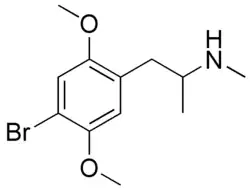Methyl-DOB
 | |
| Names | |
|---|---|
| Preferred IUPAC name
1-(4-Bromo-2,5-dimethoxyphenyl)-N-methylpropan-2-amine | |
| Other names
N-Methyl-DOB; 4-Bromo-2,5-dimethoxy-N-methylamphetamine
| |
| Identifiers | |
3D model (JSmol)
|
|
| ChEMBL | |
| ChemSpider | |
PubChem CID
|
|
| UNII | |
CompTox Dashboard (EPA)
|
|
| |
| |
| Properties | |
| C12H18BrNO2 | |
| Molar mass | 288.181 g/mol |
Except where otherwise noted, data are given for materials in their standard state (at 25 °C [77 °F], 100 kPa).
Infobox references
| |
Methyl-DOB, or N-methyl-DOB, also known as 4-bromo-2,5-dimethoxy-N-methylamphetamine, is a lesser-known psychedelic drug.[1] It is similar in structure to DOB. Methyl-DOB was first synthesized by Alexander Shulgin. In his book PiHKAL (Phenethylamines i Have Known And Loved), the minimum dosage is listed as 8 mg, and the effects onset begin after 3 hours and last up to 36 hours. Methyl-DOB produces many physical effects, such as mydriasis and muscle tenseness, but few psychoactive effects. Very little data exists about the pharmacological properties, metabolism, and toxicity of Methyl-DOB.
See also
- DOx (psychedelics)
- N-Methyl-DOI
- IDNNA (N,N-dimethyl-DOI)
- N-Methyl-2C-B
- Beatrice (N-methyl-DOM)
- N-Methyl-DOET
- N-Methyl-TMA-2
References
- ^ Shulgin, Alexander; Shulgin, Ann (September 1991). PiHKAL: A Chemical Love Story. Berkeley, California: Transform Press. ISBN 0-9630096-0-5. OCLC 25627628.
External links